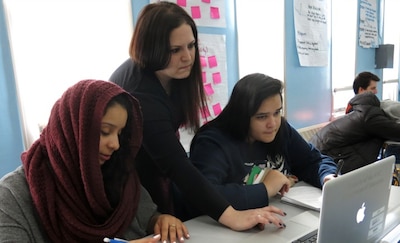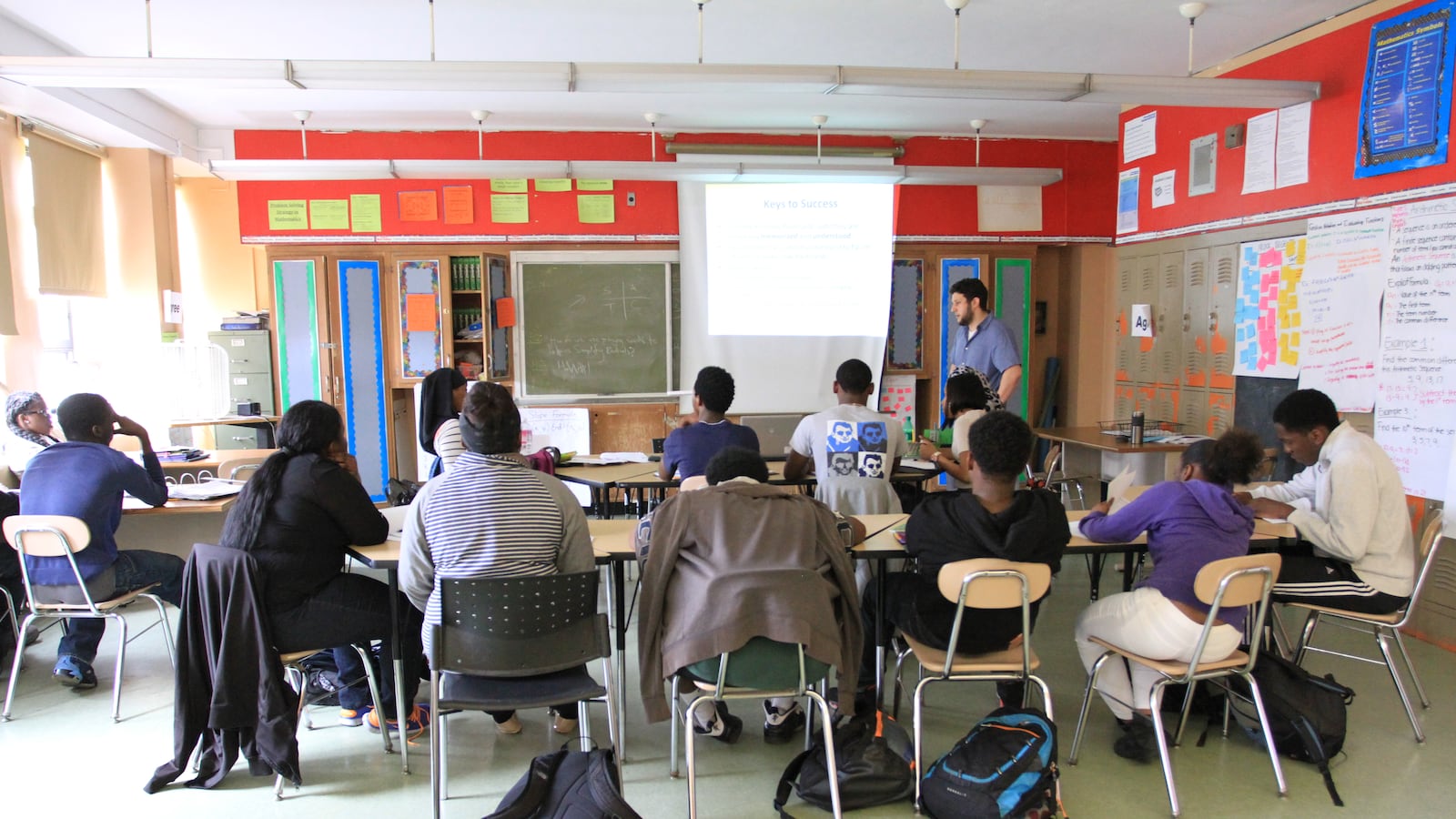When Mayor Bill de Blasio recently unveiled his plan to give all eighth-grade students access to algebra, he dove into an issue that has stumped policymakers in the past.
He and others are convinced middle-school algebra classes can catapult students toward high-level math in high school and college. But other districts have faced dilemmas that de Blasio is hoping to avoid — either they reach too few students, often excluding low-income and minority students from critical coursework, or they reach too many, setting up unprepared students for failure.
“I don’t think we have any examples of any district or state successfully getting [all] kids into eighth-grade algebra and having them succeed,” said Joshua Goodman, an associate professor of public policy at Harvard University who studied algebra enrollment in Wake County, N.C.
De Blasio is seeking a middle ground where middle-school algebra courses are universally available, yet students are not required to take them. Still, that compromise leaves the city with a massive challenge: how to make sure that disadvantaged or struggling students are not left out of the new classes, and that the courses are strong enough to set up students for high school.
“Students who successfully pass algebra by the end of ninth grade are more likely to graduate from high school and go on to college or a career,” de Blasio said during his policy announcement in September. “But many students don’t pass algebra by the end of ninth grade because we haven’t prepared them to succeed in the class.”
Why algebra?
De Blasio’s effort to get every middle school to offer algebra could benefit two groups of students.

First are high-achieving students who are ready for algebra and need it to be on track to take advanced math in high school, but their middle schools currently are without the course.
Then there are lower-performing students who could use the early exposure to a subject that trips up many students in high school. Almost one in three New York City test-takers in 2014 flunked the Integrated Algebra exam on their first try — a proportion that some worry could climb as the exam becomes more difficult.
Algebra is difficult for so many that some advocate striking it entirely as a graduation requirement. Students who want to fix cars or repair air conditioners should not lose a diploma because they can’t solve for “x,” said Andrew Hacker, a professor at Queens College who has argued against the “algebra for all” movement.
“It’s like saying let’s make all students learn to play the cello,” said Hacker. “The question is why? The cello is a beautiful instrument and all the rest, but not everybody is going to be musical in the rest of their lives.”
But most acknowledge that algebra is a critical subject. Even without pursuing a career in math or science, it is important for students not to freeze when looking at numbers, said Jacob Vigdor, a professor at the Evans School of Public Policy and Governance at University of Washington. And for more advanced students, taking algebra in eighth grade is the easiest way to be on track to take high-level math classes that will help them reach college.
Pitfall 1: Pushing too many kids into algebra
So it’s no surprise that states and districts have sought to enroll more middle-school students in algebra.
In 2008, California made algebra an eighth-grade requirement, and thousands of middle school students poured into algebra classrooms. A study later found that students who had enrolled in eighth-grade algebra performed worse on 10th-grade math tests. Similar stories unfolded in North Carolina and Chicago when schools instituted algebra for all policies.
Julie Spykerman, who taught high school math in Anaheim, Calif., at the time, said she could see right away that the policy hurt students who were not ready for algebra. To compensate for unprepared students, teachers watered down the curriculum and frantically taught to the state’s algebra test, she said, while students memorized concepts to pass the exam, but were lost in higher-level math.
“It just messed things up,” Spykerman said. “It wasn’t pretty. Teachers weren’t feeling good about what they were doing. Kids were failing. Parents were unhappy.”
Pitfall 2: Disadvantaged students are excluded
New York City officials say they don’t want to see students take algebra in eighth grade who are not prepared for it. That’s why they say they are simply making the class an option, not a requirement.

But making advanced classes optional is one reason that fewer disadvantaged students tend to take them, said Goodman, the public policy professor. When teachers are tasked with choosing students for advanced classes, they usually pick high performers who are often privileged, resulting in fewer low-income, black and Hispanic students in the classes, he said.
Goodman said the city must “be proactive in getting all kinds of racial, gender, and income groups to consider those classes equally” and continually monitor its progress.
“You wouldn’t want a world in which somebody opens up access and it becomes all the students from white families,” he said.
The city’s strategy for avoiding that scenario is to offer algebra in every middle school, rather than the 60 percent that currently offer it and among those schools, fewer than 30 percent of students take the state algebra exam.
They’re taking a page from recent efforts to get more black and Hispanic students into advanced high school classes. Historically, schools that enroll a large proportion of black and Hispanic students have
By adding algebra classes at the 40 percent of schools that don’t currently offer it, 15,000 more students will get a chance to take the class, although city officials did not say how they will select students for the classes or what percentage of students they hope will take them.
New York’s challenge occupying the middle ground
The city also has a plan to avoid plunging potentially thousands of students into courses they aren’t prepared for, as other districts have done. That plan is centered on improving math preparation for students long before they reach 8th grade.
Revamping math instruction will take significant teacher training, curriculum changes, and setting up students early on to grasp more advanced concepts.
One of hardest logistical issues may be finding qualified teachers, said Tom Loveless, an education researcher at the Brookings Institution. Often, middle-school teachers are not prepared to teach high-school math, he said.
The city will tackle this issue, in part, by increasing teacher training for fifth-grade teachers this year, which will continue into the summer. It will also start training for middle school teachers in the summer of 2016, continuing into the fall of 2016.
Even with trained teachers, it is hard to teach algebra to students who “think it’s a foreign language,” said Sean Blanks, who teaches middle school math at I.S. 392 in Brownsville. A change will require teaching variables at an earlier age and clearly diagnosing problems when students begin struggling, he said.
Despite these difficulties, Blanks said he thought more of his students could handle an advanced math class if given the right preparation. “It can be done,” he said.
For students, the city plans to increase math support by emphasizing algebra concepts such as operations, fractions, and decimals with all students as early at fifth grade, department officials said. Currently, fractions and operations are part of the 5th grade Common Core curriculum. The city will also add summer programs for rising eighth and ninth graders to bolster their math skills.
Still, it remains an open question how these programs will be implemented and whether they can shift algebra readiness in the nation’s largest school district.
“It’s all about how it’s actually going to get rolled out,” said Kim Nauer, education research director at the New School’s Center for New York City Affairs.

